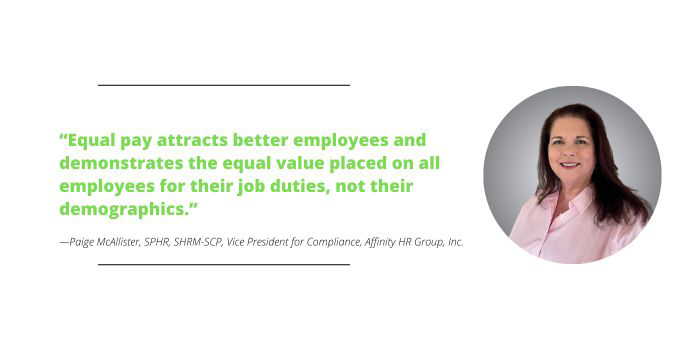Pay equity means compensating all employees equally for equal or similar work, regardless of factors such as race, gender, ethnicity, disability, sexuality, religion and age. Compensation is anything of value including salary, benefits and perks.
Persistent Disparities
Several federal laws – including the Equal Pay Act, Title VII of the Civil Rights Act, the Age Discrimination in Employment Act and the Americans with Disabilities Act – have been enacted to prevent pay inequity; however, they have resulted in slow progress in the gender pay gap.
- In 1963 when the Equal Pay Act became federal law, overall, women in the workforce made 59 cents for every $1 earned by male workers. In 2022, almost 60 years after the law was passed, women earned 82 cents (17% less) for every $1 made by a male worker. Following this rate, experts calculate that women will not receive equal pay until 2059, almost a century after passage of the EPA.
Gender pay differences in the whole workforce show even larger disparities for women of color, with Black women being paid 60 cents and Latinas being paid 55 cents for every $1 earned by white, non-Hispanic male workers.
Disparities continue when looking at education level.
- Women entering the workforce with a bachelor’s degree earn 18% less than their male counterparts, with an average salary of $52,266 per year, as compared with $64,022, respectively.
- These inequities continue with advanced degrees and by age. Over the course of a career, this equates to a loss of income of $700,000 for women with a high school degree, $1.2 million for women with bachelor’s degrees and $2 million for women with professional graduate degrees.
Even when looking at pay with all factors being equal, overall, women still on average only earn 99 cents for every dollar with no justifiable reason. Even in these groups, disparities increase with age, advanced degree and advancement in the role as women have fewer opportunities for advancement and salary increases. For example, among Fortune 500 CEO’s, women make 95 cents for every 41 made by a man, However, only 8% of these CEO’s are women.
Remedies
To help level the playing field, many states have or are looking to pass laws to better ensure equitable pay impacting nearly one out of five people. In general, these laws fall into three categories:
- Pay transparency laws are intended to require employers to pay all new hires fairly and consistently for the job they will be doing. They require companies to develop good-faith pay ranges for all positions based on the job duties regardless of who applies or is hired. Some states require this information to be included in any external or internal job posting while others require it be given to any current employee who asks for it. Laws vary as to how this applies to remote employees who are located within or outside of a state with this law.
- Pay history laws are intended to mitigate the impacts of lower past pay by compelling employers to pay for the job duties the person will be performing, not based on what they were paid before. These laws prohibit current and prospective employers from asking an employee or applicant for their past salary history to use as a guide for future salary offers. Some states prohibit just pay while others prohibit asking about any compensations such as commissions, bonuses, or benefits.
- Pay reporting laws require employers to submit comprehensive data to the state so their wage practices can be monitored. Normally these reports require wage information by job, gender, race, and ethnicity, similar to the EEO-1 report.
It should also be noted that the National Labor Relations Act allows employees to discuss their own salaries, so prohibiting employees from discussing pay is not a valid strategy.

Equitable Company Policies
Even employers in states without such pay equity laws should consider making pay equity common practice as equal pay attracts better employees and demonstrates the equal value placed on all employees for their job duties, not their demographics.
There are several ways employers of all sizes and industries in any state can progress toward better pay equity:
- Educate your organization on pay inequity, its impacts, and thoughts to reduce it in your company. Some good resources are Forbes Advisor’s What is Pay Equity and Why Is It Important, Pew Research Center’s Gender pay gap in US hasn’t changed much in two decades, PayScale’s 2023 Gender Pay Gap Report, and Forbes Advisor’s Gender Pay Gap Statistics in 2023.
- Develop a compensation strategy which reflects the company’s values that will dictate how much you will pay, how you will compare to the market, when exceptions will be made, what factors will be considered, and who can make comp decisions. Ensure that anyone empowered to make pay decisions is properly trained on the possible impacts of discrimination, implicit or unintentional bias, and disparate impact.
- Conduct a thorough comp / pay review to understand what each employee is earning. Include factors such as race, gender, seniority, experience, education, etc. to factually evaluate equity among groups. Engage an outside resource to provide an unbiased, well-researched evaluation so you know the starting point and where you need to improve.
- Update job descriptions with accurate job duties, responsibilities, and requirements to determine legitimate pay differentiators.
- Create pay bands which encompass the pay for every employee in that position. Have enough difference to allow for advancement but not so much that the band becomes arbitrary.
- Link compensation to DEI strategy to give all employees access to not only equitable pay but to the same tools for their success such as opportunities, training, mentorships, feedback, and access to management.
- Regularly review and update all of the above to ensure they are current and consistent.
Even employers with the best intentions may face challenges to consistent pay equity practices given the changing nature of the business world:
- Economic impacts, such as an increasing cost-of-living, give employees less options to work for less just because they like a company.
- The workforce is changing, becoming smaller, younger, and more diversified, so overall, potential employees have different priorities and more options for employment.
- The workforce is more remote, so it may be harder to compare job duties or working conditions or to create a salary band that satisfies the varying cost-of-living rates in the areas where employees or applicants live.
At the end of the day, pay equity is about fairness. Pay equals value, and all employees should be valued equally for what they bring to your organization, not due to their gender, race, or lifestyle.
Affinity HR Group Q&A July 2023
Question: We decided to offer our employees some flexibility over the summer by letting them flex their schedule and dress more casually. Now that summer is ending, we want to change back to our former requirements after Labor Day. However, some employees are acting like we need to allow them this flexibility going forward. Do we?
Answer: Most employers have the right to dictate policies and procedures such as work schedule and dress code. Usually, these policies can be changed at any time at the discretion of the company. Just like you relaxed them at the beginning of the summer, you can reinstitute the stricter guidelines after summer. Even if employees did not realize they were temporary changes, you can change them back. Of course, if employees are unhappy, they have the right to search elsewhere for employment if that new-found flexibility is important to them.
Rather, the question to ask yourself is “Do the changes need to be reversed?” If productivity stayed the same (or maybe even improved), do you really need to go back to the way things were? But, if there are legitimate reasons to return to the status quo (ie. Summer is typically slow but you get busy again in the fall), explain that to your employees so they know it is not an arbitrary decision.
If your employees react so favorably to small efforts like that, perhaps consider other ways to offer employees some form of flexibility in the future to keep them engaged and happy.
McAllister is vice president for compliance at Affinity HR Group, Inc., PPAI’s affiliated human resources partner. Affinity HR Group specializes in providing human resources assistance to associations such as PPAI and their member companies. To learn more, visit www.affinityHRgroup.com.


